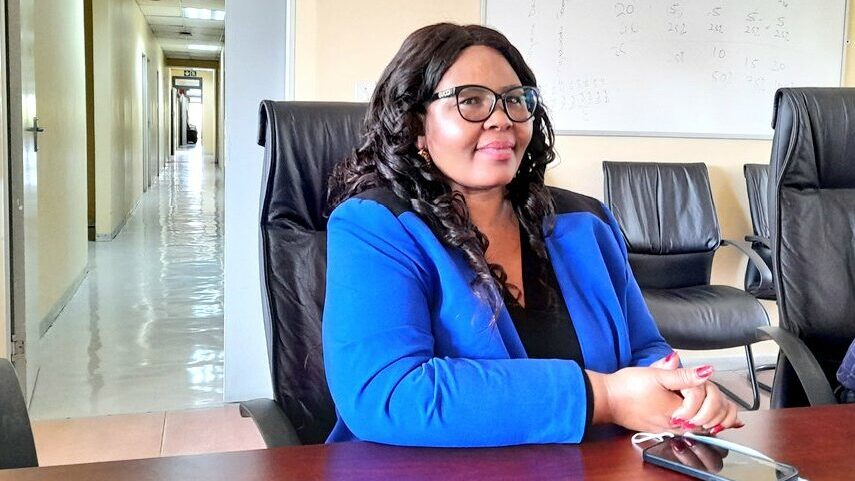In the Hot Seat: New Gauteng Health MEC Responds to 10 Questions from Spotlight

By Spotlight Editors
On 7 October, Gauteng Premier Panyaza Lesufi appointed Nomantu Nkomo-Ralehoko to the position of MEC for Health in the province. Nkomo-Ralehoko replaced Nomathemba Mokgethi, who had been in the job for less than two years.
The position of MEC for Health in Gauteng is one of the most important, and probably one of the toughest public sector health jobs in South Africa. Spotlight sent Nkomo-Ralehoko ten questions about her plans and on the chronic problems plaguing health in Gauteng. We received the below responses via Tshepo Shawa, the MEC’s spokesperson.
1. After the murder of Babita Deokaran, the Gauteng Health Department was very slow to follow up on the alleged corruption that Deokaran had exposed at Tembisa Hospital. What steps will you take as MEC to ensure that the alleged corruption at Tembisa Hospital is fully investigated and that justice is done?
Nkomo-Ralehoko: The Gauteng Provincial Government has already, through the Office of the Premier, taken action to ensure that the Special Investigating Unit (SIU) conducts a forensic investigation into the transactions at Tembisa Hospital. I am also aware that the Hawks are probing the matter.
I have made a commitment that as soon as the SIU concludes the forensic investigation, we will definitely not hesitate to act on the recommendations.
Sometimes, justice might seem delayed, but it is important that we allow law enforcement agencies to complete their work so that firm action can be taken where there is wrongdoing.
2. From PPE-related corruption to alleged corruption at Tembisa Hospital, the Gauteng Department of Health appears to have a chronic and systemic problem with corruption. What steps will you take as MEC to:
i) root out corruption in the department at a systemic level;
ii) and ensure there are consequences for those implicated?
Nkomo-Ralehoko: One of my immediate focus areas is to ensure that the department’s systems across delivery areas such as Finance, Human Resources, Monitoring and Evaluation, Risk Management, etc. are strengthened so that processes are not dependent on human vulnerability but there are clear checks and balances.
An environment that has no consequence management breeds ill-discipline and a culture of ignoring processes and procedures as prescribed in our legislative framework. Our environment is highly regulated through various prescripts and it is important for oversight purposes and for good governance that the distinctive roles in terms of the role of Executive Authority and the role of Accounting Officer are appreciated.
I have already made an undertaking to work with stakeholders internally and externally to ensure that there is accountability and consequence management. Equally so, it will be important to also recognise people that go beyond the call of duty. We need to encourage an environment where we get back to the Batho Pele principles by ensuring that our work is geared towards improving patient experience of care and improving our service offering. We also need to make sure that employees work in an environment that appreciates the service they are rendering to communities and allows them to thrive.
3. The work of restoring Charlotte Maxeke Johannesburg Academic Hospital was handed over to the National Department of Health after the Gauteng government botched the job. What steps will you take as MEC to ensure that Charlotte Maxeke is fully functional again as soon as possible?
(Here, the MEC referred us to a response provided to the provincial legislature regarding the rebuilding of Charlotte Maxeke)
4. There have in recent years been chronic management-level vacancies in the Gauteng Department of Health. What steps will you take as MEC to ensure that all vacancies in the department are filled with suitably qualified people?
Nkomo-Ralehoko: Part of the intervention programme for the remainder of the 6th Administration term of office will be to review the age-old organisational structure which was last updated in 2006 to ensure that it is relevant and fit-for-purpose and takes into consideration the size of the Gauteng healthcare system and the kind of skills that are needed to provide adequate and effective care to the over 16 million people of the province, majority of whom rely on the public healthcare system.
We have put in place an ambitious plan called Turning The Tide: Reclaiming the Jewel of Public Health in Gauteng, which looks at a number of intervention areas. Key amongst these is the Human Resource component.
This is to ensure that we have a structure that responds adequately to clinical, administrative, social, and economic challenges faced by the province. This will enable the department to be able to deliver on the workforce that positively impacts its strategy execution efforts and acceptable levels of organisational performance.
5. Are you in favour of cadre deployment in the provincial health department?
Nkomo-Ralehoko: If by cadre deployment you mean a situation where highly trained and qualified personnel who understand the delivery imperatives of the developmental state and are committed to a high ethical standard embracing a culture and ethos of service, then indeed I am for cadre development.
However, if by cadre development you are referring to bringing incapable and unqualified people into the public service at the expense of delivery, then I can’t support such.
6. Healthcare workers often work under very difficult conditions and surveys have shown that many healthcare facilities are understaffed. What steps will you take as MEC to ensure sufficient numbers of healthcare workers are employed in Gauteng and work under decent working conditions?
Nkomo-Ralehoko: Kindly refer to the response to question 4 above. Additional to that response is that the Turning the Tide plan has also prioritised health infrastructure to ensure that healthcare workers work in a safe environment.
Our Department is now called the Department of Health and Wellness that on its own is a clear indication that issues of wellness will also receive special focus. We can’t preach a message of wellness while our employees are unwell and unhappy. In my first address to the staff at head office on 10 October 2022, I made a commitment to the team that charity will begin at home. For this reason, we will soon be rolling out Wellness Wednesdays, the aim of which is to bring the spotlight on employee wellness and to ensure that we pay more attention to the softer but critical issues that make the workplace a more conducive environment.
7. In your view, what is the key difference between the role of the MEC for health and the HoD of the province’s health department?
Nkomo-Ralehoko: The roles of the Executive Authority (MEC) and Accounting Officer (HoD) are clearly defined by various laws and regulations, such as the Public Service Act, Public Service Regulations, and Public Finance Management Act. The executive authority is the political head and is responsible for policy direction and oversight. The executive authority delegates certain functions to the accounting officer to ensure effective public management and administration.
The accounting officer is the administrative head of the department and is responsible for the day-to-day operations of the department.
8. As MEC, will you listen to and support healthcare workers like Dr Tim de Maayer who blow the whistle when the situation at health facilities becomes untenable, or will you take steps against such people?
Nkomo-Ralehoko: I have made a commitment to staff to work with them to turn the health system around. This means that performance systems and tools will have to be strengthened while we also create a conducive environment that allows employees to be heard. Everyone’s voice matters if it is a voice that seeks to move us forward. We all have a role to play to restore the tarnished image of the Gauteng public health system.
9. As the province’s new MEC for Health, what lessons do you take from the Life Esidemeni tragedy?
Nkomo-Ralehoko: You will appreciate that I am just a few days in office and I am obviously getting appraised with the myriad of issues confronting the healthcare system in the province. One of the commitments made by this 6th Administration was to be a patient-centred, clinician-led, and stakeholder-driven healthcare system. This is a commitment we intend to see through in the remaining period of the term of office. My job is to ensure that patients are at the centre of our work by giving clinicians space to do what they are trained to do while at the same time listening to the voice of the many stakeholders who want to see public health live up to its promise.
10. As we understand, you are not a medical doctor and in a SABC interview you said you are “a politician by accident”. What in your background and experience would you say makes you the right candidate for the role of MEC for Health?
Nkomo-Ralehoko: Yes I said I am a politician by accident given that I was drawn by many lived experiences which harnesses the activist in me that was driven to change things for the better. I am an administrator at heart, but I am also an experienced leader, having led across various structures in society.
I understand the plight of the people of Gauteng and I am committed to putting my skills and knowledge to change things for the better. I may not be a clinician or a nurse, but I do know that the healthcare system is nothing without healthcare workers.
Republished from Spotlight under a Creative Commons 4.0 Licence.
Source: Spotlight





